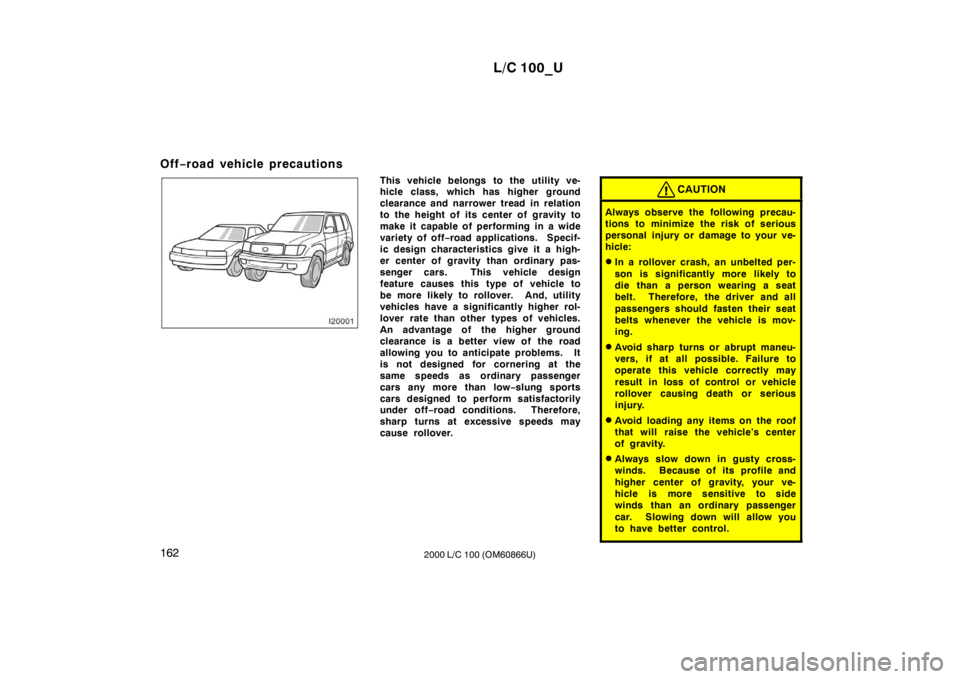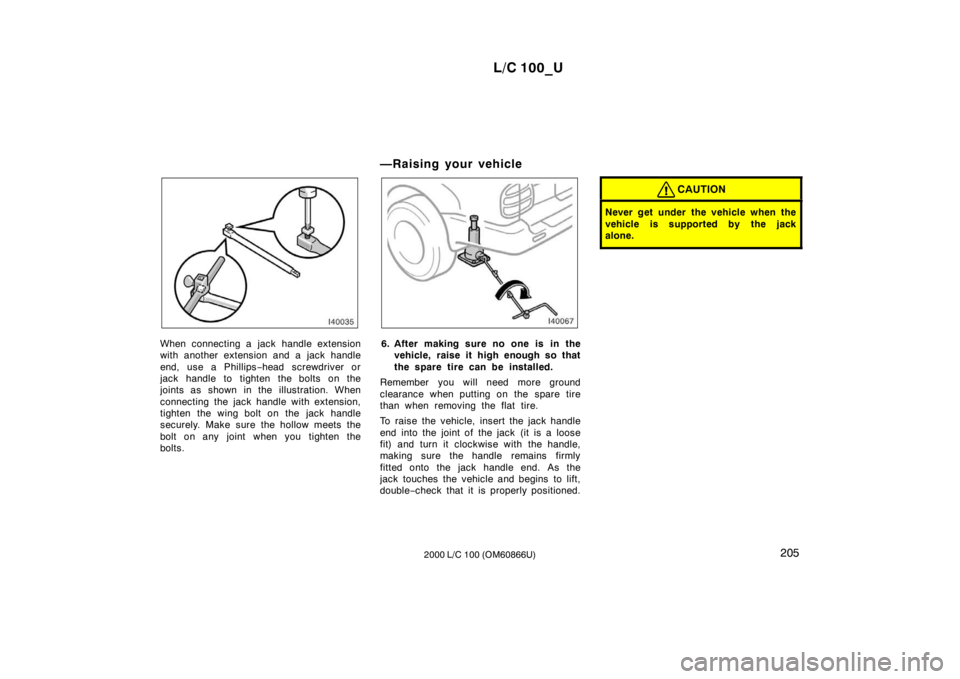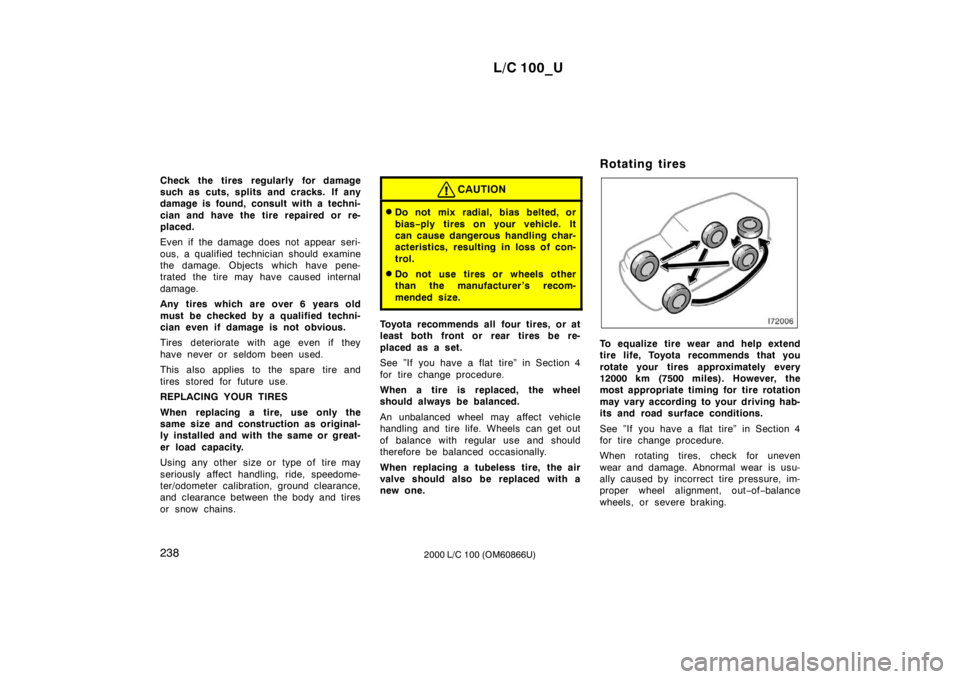2000 TOYOTA LAND CRUISER ground clearance
[x] Cancel search: ground clearancePage 140 of 235

L/C 100_U
162 2000 L/C 100 (OM60866U)
Off
−road vehicle precautions
This vehicle belongs to the ut ility ve-
hicle class, which has higher ground
clearance and narrower tread in relation
to the height of its center of gravity to
make it capable of performing in a wide
variety of off −road applications. Specif-
ic design characteristics give it a high-
er center of gravity than ordinary pas-
senger cars. This vehicle design
feature causes this type of vehicle to
be more likely to rollover. And, utility
vehicles have a significantly higher rol-
lover rate than other types of vehicles.
An advantage of the higher ground
clearance is a better view of the road
allowing you to anticipate problems. It
is not designed for cornering at the
same speeds as ordinary passenger
cars any more than low −slung sports
cars designed to perform satisfactorily
under off −road conditions. Therefore,
sharp turns at excessive speeds may
cause rollover.CAUTION
Always observe the following precau-
tions to minimize the risk of serious
personal injury or damage to your ve-
hicle: � In a rollover crash, an unbelted per-
son is significantly more likely to
die than a person wearing a seat
belt. Therefore, the driver and all
passengers should fasten their seat
belts whenever the vehicle is mov-
ing.
� Avoid sharp turns or abrupt maneu-
vers, if at all possible. Failure to
operate this vehicle correctly may
result in loss of control or vehicle
rollover causing death or serious
injury.
� Avoid loading any items on the roof
that will raise the vehicle’s center
of gravity.
� Always slow down in gusty cross-
winds. Because of its profile and
higher center of gravity, your ve-
hicle is more sensitive to side
winds than an ordinary passenger
car. Slowing down will allow you
to have better control.
Page 169 of 235

L/C 100_U205
2000 L/C 100 (OM60866U)
When connecting a jack handle extension
with another extension and a jack handle
end, use a Ph illips−head screwdriver or
jack handle to tighten the bolts on the
joints as shown in the illustration. When
connecting the jack handle with extension,
tighten the wing bolt on the jack handle
securely. Make sure the hollow meets the
bolt on any joint when you tighten the
bolts. —Raising your vehicle6. After making sure no one is in the
vehicle, raise it high enough so that
the spare tire can be installed.
Remember you will need more ground
clearance when putting on the spare tire
than when removing the flat tire.
To raise the vehicle, insert the jack handle
end into the joint of the jack (it is a loose
fit) and turn it clockwise with the handle,
making sure the handle remains firmly
fitted onto the jack handle end. As the
jack touches the vehicle and begins to lift,
double −check that it is properly positioned.
CAUTION
Never get under the vehicle when the
vehicle is supported by the jack
alone.
Page 202 of 235

L/C 100_U
238 2000 L/C 100 (OM60866U)
Check the tires regularly for damage
such as cuts, splits and cracks. If any
damage is found, consult with a techni-
cian and have the tire repaired or re-
placed.
Even if the damage does not appear seri-
ous, a qualified technician should examine
the damage. Objects which have pene-
trated the tire may have caused internal
damage.
Any tires which are over 6 years old
must be checked by a qualified techni-
cian even if damage is not obvious.
Tires deteriorate with age even if they
have never or seldom been used.
This also applies to the spare tire and
tires stored for future use.
REPLACING YOUR TIRES
When replacing a tire, use only the
same size and construction as original-
ly installed and with the same or great-
er load capacity.
Using any other size or type of tire may
seriously affect handling, ride, speedome-
ter/odometer calibration, ground clearance,
and clearance between the body and tires
or snow chains.
CAUTION
�
Do not mix radial, bias belted, or
bias −ply tires on your vehicle. It
can cause dangerous handling char-
acteristics, resulting in loss of con-
trol.
� Do not use tires or wheels other
than the manufacturer ’s recom-
mended size.
Toyota recommends all four tires, or at
least both front or rear tires be re-
placed as a set.
See ”If you have a flat tire” in Section 4
for tire change procedure.
When a tire is replaced, the wheel
should always be balanced.
An unbalanced wheel may affect vehicle
handling and tire life. Wheels can get out
of balance with regular use and should
therefore be balanced occasionally.
When replacing a tubeless tire, the air
valve should also be replaced with a
new one. Rotating tires
To equalize tire wear and help extend
tire life, Toyota recommends that you
rotate your tires approximately every
12000 km (7500 miles). However, the
most appropriate timing for tire rotation
may vary according to your driving hab-
its and road surface conditions.
See ”If you have a flat tire” in Section 4
for tire change procedure.
When rotating tires, check for uneven
wear and damage. Abnormal wear is usu-
ally caused by incorrect tire pressure, im-
proper wheel alignment, out
−of −balance
wheels, or severe braking.
Page 204 of 235

L/C 100_U
240 2000 L/C 100 (OM60866U)
Regulations regarding the use of tire
chains vary according to location or
type of road, so always check them
before installing chains.
NOTICE
If the wrong combination of tire and
chain is used, the chains could dam-
age the vehicle body.
CHAIN INSTALLATION
Install the chains on the rear tires as
tightly as possible. Do not use tire
chains on the front tires. Retighten
chains after driving 0.5—1.0 km
(1/4—1/2 mile).
When installing chains on your tires, care-
fully follow the instructions of the chain
manufacturer.
If wheel covers are used, they will be
scratched by the chain band, so remove
the covers before putting on the chains.
CAUTION
�
Do not exceed 50 km/h (30 mph) or
the chain manufacturer ’s recom-
mended speed limit, whichever is
lower.
� Drive carefully avoiding bumps,
holes, and sharp turns, which may
cause the vehicle to bounce.
� Avoid sharp turns or locked −wheel
braking, as use of chains may ad-
versely affect vehicle handling.
Replacing wheels
WHEN TO REPLACE YOUR WHEELS
If you have wheel damage such as
bending, cracks or heavy corrosion, the
wheel should be replaced.
If you fail to replace damaged wheels, the
tire may slip off the wheel or cause loss
of handling control.
WHEEL SELECTION
When replacing wheels, care should be
taken to ensure that the wheels are re-
placed by ones with the same load ca-
pacity, diameter, rim width, and offset.
Correct replacement wheels are available
at your Toyota dealer.
A wheel of a different size or type may
adversely affect handling, wheel and bear-
ing life, brake cooling, speedometer/odom-
eter calibration, stopping ability, headlight
aim, bumper height, vehicle ground clear-
ance, and tire or snow chain clearance to
the body and chassis.
Page 233 of 235

00MY L/C 100(U)
iii 2000 L/C 100 (OM60866U)
Installation of a mobile
two −way radio system
As the installation of a mobile two −way radio system in
your vehicle could affect electronic systems such as
multiport fuel injection system/sequential multiport fuel
injection system, electronic throttle control system,
cruise control system, anti −lock brake system, SRS air-
bag system and seat belt pretensioner system, be sure
to check with your Toyota dealer for precautionary mea-
sures or special instructions regarding installation.
Scrapping of your Toyota
The SRS airbag and seat belt pretensioner devices in
your Toyota contain explosive chemicals. If the vehicle
is scrapped with the airbags and pretensioners left as
they are, it may cause an accident such as a fire. Be
sure to have the systems of the SRS airbag and seat
belt pretensioner removed and disposed of by a qualified
service shop or by your Toyota dealer before you dis-
pose of your vehicle.
On −pavement and off −road
driving tips
This vehicle belongs to the utility vehicle class. Utility
vehicles have a significantly higher rollover rate than other
types of vehicles. This vehicle will handle and maneuver
differently from an ordinary passenger car because it is
designed for off −road use also. In addition, this vehicle
has a higher ground clearance and center of gravity than
that of an ordinary passenger car. This vehicle design
feature causes this type of vehicle to be more likely to
rollover. Failure to operate this vehicle correctly may result
in loss of control, accidents or vehicle rollover causing
death or serious injury. Be sure to read ”Off −road vehicle
precautions” in Section 2 and ”Off −road driving precautions”
in Section 3.